Tsum Valley Travel Guide: Attraction, Best Time & Difficulty
Located in northern Gorkha and surrounded by giant mountains like Boudha Himal, Himalchuli, Ganesh Himal, and Shiring Himal, Tsum Valley is among the remotest Himalayan valleys.
The location of the valley explains why it is known as a hidden valley. It is an exclusive destination in the Himalayas that only a handful of travellers explore every year.
The valley is rich in nature, art, architecture, and religion. Here, you will meet the Tsumba community of Nepal. Locals are still very much connected to their roots and faiths and have origins in Tibet.
The proximity to Tibet has resulted in Tibetan Buddhism’s dominance in the region. The locals have their own dialect but share similar practices, beliefs, and traditions with Tibetans.
Trekking in the Tsum Valley is a privilege. Not many trekkers know about this special trekking region, so the trails are peaceful and the valley remains untouched.
If you are searching for a unique trek experience or want to explore not famous but mysterious parts of the Himalayas, Tsum Valley is your answer. For better trek planning, safety, and seamless travel support, be sure to rely on a trusted Tsum Valley travel guide.
Overview of Tsum Valley Trek
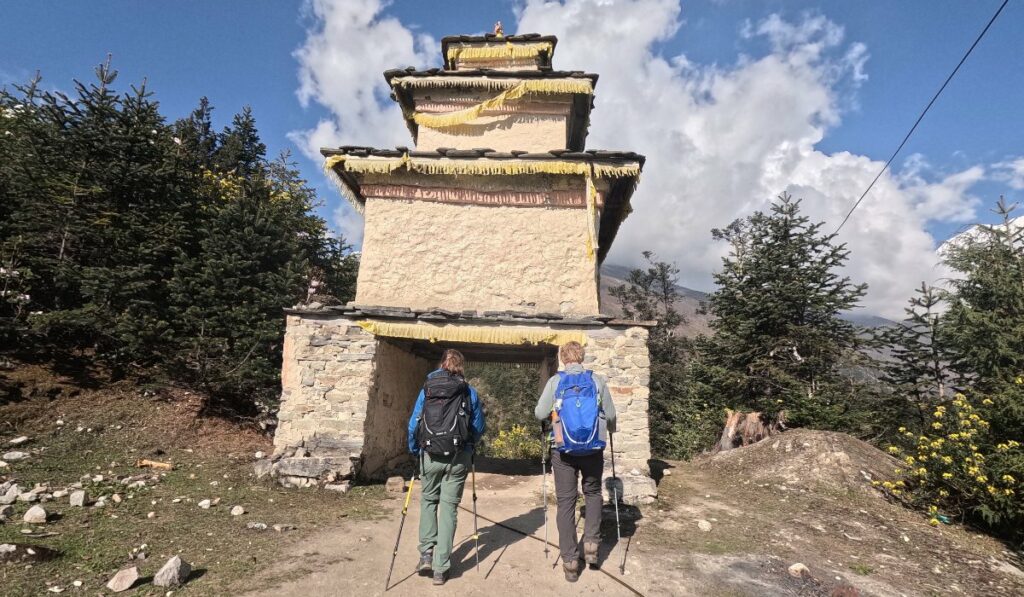
“Do you want to explore the authentic Himalayas, untouched by tourism? Are you ready to push your limits in one of the secluded corners of the great Himalayas? Do you want to see heavenly scenery and mountain vistas? Then, join us on the Tsum Valley trek!”
The Tsum Valley is located within the Manaslu region. The trail follows the Manaslu Circuit route for the first three days, separates from Lokpa village, and enters Tsum Valley. Chumling is the first main village you will come across in the lower Tsum Valley. The trail then ascends along the Shair Khola to Chhokang Paro, the main village in the upper Chhokang Paro.
From Chhokang Paro, you will hike to the Nile settlement, the last village in the upper Tsum Valley. A final hike will take you to Mu Gompa. You will also explore Milarepa’s Cave and Dephyudonma Gumba.
After two nights in the Nile settlement, you will descend to Gho village and hike to Gumba Lungdang. From here, the trail descends to Ripchet and follows the same route back to Soti Khola. On the way, you will spend nights in Philim and Khorla Besi. The Tsum Valley was opened for tourists in 2008 with a restricted area status. So, foreigners have to obtain a special restricted area trekking permit from the government of Nepal to trek here.
Not only that, they also have to follow strict rules, and trekking with a local authorized trekking company like us is mandatory. As you trek from Soti Khola to Mu Gompa, you will traverse diverse climatic zones and explore a wide range of flora and fauna. The valley is home to exotic animals like the snow leopard and the Danphe (the national bird of Nepal).
Though spotting a snow leopard is rare, you may see Danphe, blue sheep, alpine yaks, Himalayan tahr, etc, during trekking.
Every day, you will gain around 500 meters in elevation, which means you can look forward to different scenery every day. Likewise, the mountain views get prominent as you hike higher.
At the upper part of the valley, you will be surrounded by the pure bliss of snow-covered mountains, glaciers, and alpine meadows.
The hospitality, generosity, and kindness of the locals will make your time in this isolated part of the world even more meaningful. The great thing about the trek is that you also have the Tsum Valley trek with the Manaslu trek combine alternative.
Cultural Highlights of Tsum Valley
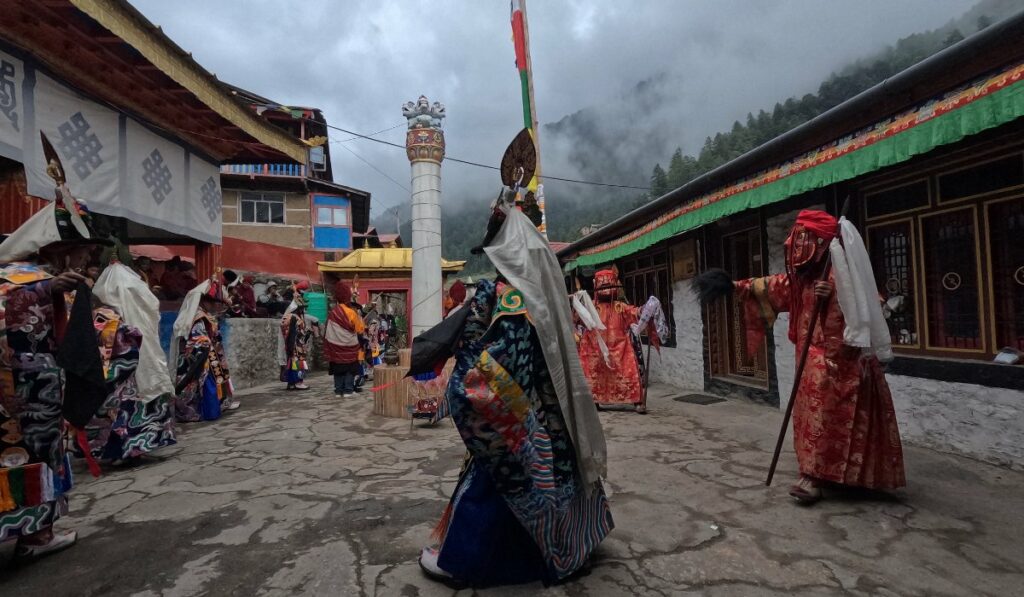
- Ancient Monasteries: Mu Gompa, Rachen Gompa, Dephyudonma Gompa.
- Unique Traditions: Polyandry system (one wife with multiple husbands).
- Festivals: Local celebrations like Lhosar (Tibetan New Year).
Tsum Valley is rich in Buddhism. The region is very close to Tibet, so the locals practice Tibetan Buddhism. In addition to that, the locals’ lifestyles, homes, and practices are very similar to Tibetans.
This secluded region was also a meditation place for the great sages like Padmasambhava and Milarepa. For instance, you will visit Milarepa’s Cave, also known as Pigeon Cave, during the Tsum Valley trek.
Similarly, the valley also has many ancient stupas and monasteries such as Mu Gompa, Dephyudonma Gumba, and Rachen Gompa. Mu Gompa is the highest gompa located at 3,700 meters. It was established in 1985 AD.
Rachen Gompa is located in the northern part of Tsum Valley in Chhule village. You can hike here during your acclimatization day in the Nile settlement or follow a different route that goes through this gompa while descending from the Nile to Chumlling.
Apart from the stupas and monasteries in the Tsum Valley, another interesting thing is the practices and beliefs of the locals. For example, the locals still follow the polyandry system, so one woman usually has multiple husbands.
You will get to know more things like this during the trek.
Why Trek to Tsum Valley?
Below, we have shared some of the reasons that make the Tsum Valley trek a perfect adventure holiday for you in the Himalayas:
Untouched beauty
One of the main highlights of the Tsum Valley trek is its pristine beauty. The trails are not crowded, and the locals practice their ancient customs. You will feel like you have travelled back in time. There is no sound of horns and machines.
Adventure trek:
The Tsum Valley trek is very adventurous. You will follow offbeat terrain that will keep you on your toes. Many parts of the trail are connected with suspension bridges and wooden bridges. Likewise, you may cross streams via stones and explore cascading waterfalls, deep caves, dense forests, glacier moraines, etc.
Tibetan descendants:
The locals of Tsum Valley migrated from Tibet many years ago. Their customs, language, dress, and food match Tibetans. Explore their Tibetan-style houses and the traditional mountain lifestyle. Taste the local delicacies and see how locals grow their own food.
Scenery and mountain views:
Witness mountain views of Manaslu, Ganesh Himal, Boudha Himal, Himalchuli, Shringi Himal, and many others during the trek. Likewise, you will witness many beautiful sunrises and sunsets. The views of waterfalls, streams, and rivers are also phenomenal along the trail.
Rich flora and fauna of Manaslu Conservation Area:
The Tsum Valley trekking route is under the Manaslu Conservation Area. It protects and preserves countless flora and fauna, including endangered species like the snow leopard. Explore rhododendrons, bamboo, and pine forests and see many other plants, medical herbs, and vegetation.
The great Budhi Gandaki River and gorge:
Budhi Gandaki River is one of the greatest rivers in Nepal. On the Tsum Valley trek, you will see its tributaries and cross them via a hanging suspension bridge. Likewise, the trail also goes through the Budhi Gandaki gorge, which will amaze you with its grandeur.
Best Time to Do Tsum Valley Trek in Nepal

The weather in the Himalayas is unpredictable throughout the year. However, the transition seasons like spring (March to May) and autumn (September to November) have the best trekking conditions.
The weather and climate in spring and autumn are ideal for trekking. Although other trekking regions see a huge flow of travellers in these two peak seasons, Tsum Valley remains untouched and peaceful.
Therefore, you do not have to trek in the offseason or at the start/end of the best seasons to avoid the crowd. You can fully enjoy the perks of peak trekking season during the Tsum Valley trek.
Trekking in Summer/monsoon (June to August) is not recommended due to heavy rainfall, slippery trails, and high risks of landslides.
Similarly, trekking during winter (December to February) is also demanding because of the harsh cold and heavy snowfall. But with proper preparation, you can explore the magical winter beauty of Tsum Valley.
Spring (March to May)
Spring has fine weather. Mountain views are particularly outstanding this season because the mountains are freshly covered with snow.
On top of that, the spring blooms add more beauty to the scenery. If you love flowers, then bare your heart.
The entire Himalayan foothills bloom with rhododendrons and numerous other flowers in the spring season.
You may experience some occasional snowfall in March, but with the beginning of April, the climate begins to warm up.
Summer/monsoon (June to August)
June to August is the peak summer and monsoon period in Nepal. Trekking in the Himalayas is very challenging in these months because of unstable weather and slippery trails at the lower altitudes.
Likewise, the risk of landslides is also quite high due to heavy rainfall. The climate is either too hot or too humid. The temperature goes above 35°C during the daytime.
On a good note, you will not find a single trekker on the trail. So, if you love peaceful trails, summer/monsoon is a great time to do the Tsum Valley trekking.
Similarly, if you love greenery, gushing rivers, and cascading waterfalls, this is the best time of the year to travel in nature. Note that due to heavy rainfall and clouds, mountain views may be blocked sometimes.
Autumn (September to November)
With the beginning of autumn comes the most bustling time of the year for the Himalayan trails. Foreigners love trekking in the Himalayas in autumn, and who wouldn’t?
The incredible mountain landscapes, fresh air, fall scenery, and festive dazzle make trekking in autumn phenomenal. Nepalese people celebrate their biggest festivals between October and November.
There can be occasional rainfall in September because it is the transition month. However, the climate begins to settle down and cool with the beginning of October.
The temperatures range between 20°C and 5°C. In Kathmandu, Soti Khola, and Machha Khola, the temperature may increase to 27°C. October has the longest daylight hours in the Himalayas.
Winter (December to February)
Winter trekking is controversial. In terms of weather and climate, winter is not a great time of the year to trek in the Himalayas.
The climate is very cold, and the weather is unstable. The temperature drops below -15°C.
However, if you love the winter holidays and are well-dressed for the weather, you will be absolutely fine trekking to Tsum Valley in the winter season.
Not only that, but you will witness the mystical winter beauty of the Himalayas, which very few trekkers have experienced.
The trails are all empty in the winter, and the mountain views are phenomenal. The winter fog and snow make landscapes heavenly.
Tsum Valley Trekking Route & Detailed Itinerary
The itinerary shared below is one of the best itineraries for the Tsum Valley trek. However, you can customize it as per your interest.
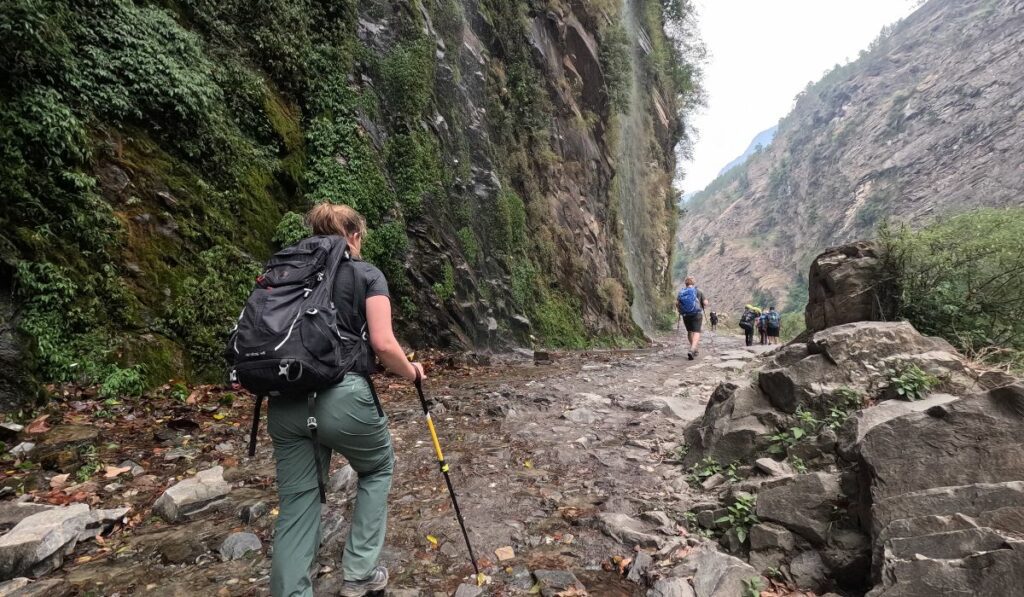
Day 1: Drive from Kathmandu to Machha Khola
Distance: 155 km/96 miles
Altitude: 890 m/2,920 ft
Duration: 7-8 hours
Accommodation: Teahouse
Meals: Breakfast, lunch, and dinner
You will start the trip after a delicious breakfast in Kathmandu. We use a local bus to drive from Kathmandu to Machha Khola. You can also opt for a private jeep by paying extra money.
The bus follows the beautiful Prithvi Highway that goes along the Trishuli River and lush rolling hills. After a few hours of driving, you will reach Dhading Bensi and drive along the Budhi Gandaki River to Arughat Bazar.
The road gets bumpy from Arughat onwards. You can see breathtaking views of Ganesh Himal and Mt. Manaslu. The mountain road follows the Budhi Gandaki River and passes by small settlements before reaching Machha Khola.
Day 2: Trek from Machha Khola to Jagat
Distance: 22.2 km/13.7 miles
Altitude: 1,340 m/4,396 ft
Duration: 6 hours
Accommodation: Teahouse
Meals: Breakfast, lunch, and dinner
We will begin this day early as well. From Machha Khola, the trail ascends and descends via lush hills and terraced fields to Tharko Khola. Crossing the river, you will enter Khorla Besi.
From here, the trail continues to Tatopani. We can take a short break here to enjoy natural hot springs. These hot springs carry healing properties and are great for your skin.
Leaving Tatopani, we will ascend to Tharo Bharyang. The trail gets narrow and crosses a suspension bridge on the way. Likewise, there is also a stone staircase just before reaching Tharo Bharyang.
The final part of the trail includes a stone-paved path to Jagat. It is situated on the west bank of the Budhi Gandaki River.
Day 3: Trek from Jagat to Lokpa (entry point to Tsum Valley)
Distance: 17 km/10.5 miles
Altitude: 2,040 m/4,493 ft
Duration: 6 hours
Accommodation: Teahouse
Meals: Breakfast, lunch, and dinner
We will register our permits at the police check post in Jagat village and continue hiking in the restricted area of the Manaslu region. The trail ascends to Salleri village and descends to Sirdibas.
We will walk through lush forests and uneven hill sides. Leaving Sirdibas, the trail crosses a long suspension bridge and takes us to Philim. From Philim, we will hike to Ekle Bhatti and ascend to Lokpa.
On the way, we may cross landslide debris. The view of the Manaslu range along the trail is breathtaking. From Lokpa, the Tsum Valley route is separate.
Day 4: Trek from Lokpa to Chumling (Lower Tsum)
Distance: 6.3 km/3.9 miles
Altitude: 2,386 m/6,692 ft
Duration: 4-5 hours
Accommodation: Teahouse
Meals: Breakfast, lunch, and dinner
Chumling is a beautiful village in the lower Tsum Valley. The trail from Lokpa to Chumling goes through a narrow gorge. On the way, you can see heavenly views of Ganesh Himal and Boudha Himal.
The trail gradually descends to Lungwa River and continues through lush rhododendron, pine, and juniper forests. Soon, you will pass by a small settlement and arrive at Syar Khola, where Chumling is situated.
The walking duration from Lokpa to Chumling is short, so you will have ample time to visit the three monasteries – Mani Dhungyur, Panago Gompa, and Gurwa Gompa.
Day 5: Trek from Chumling to Chhokang Paro
Distance: 10 km/6.2 miles
Altitude: 3,010 m/9,875 ft
Duration: 4 hours
Accommodation: Teahouse
Meals: Breakfast, lunch, and dinner
From Chumling, we will trek to Chhokang Paro, the beginning of the upper Tsum Valley. The trail goes along Shair Khola and takes you to Domje. It is the biggest village in Tsum Valley.
From Domje, we will follow an uphill trail to Chhokang Paro. On the way, we will cross landslide-prone areas and enjoy stunning views of Ganesh Himal and Himalchuli.
The environment and lifestyle of the locals are much like Tibet in Chhokang Paro. Tibetan butter tea is a specialty that you must try. Likewise, you can see Tibet-style houses.
Day 6: Trek from Chhokang Paro to Nile (via Milarepa’s Cave)

Distance: 9 km/5.5 miles
Altitude: 3,361 m/11,027 ft
Duration: 3-4 hours
Accommodation: Teahouse
Meals: Breakfast, lunch, and dinner
Our next destination is the Nile village. It is the last village in the Tsum Valley. The trail is offbeat, and the mountain views are fantastic. We will reach Milarepa’s Cave in around two and a half hours of hiking from Chhokang Paro.
Milarepa, the Buddhist scholar and yogi, is believed to have meditated in this cave. It is also known as Pigeon Cave. From here, you will trek past green meadows to Nile village, crossing a suspension bridge over Shair Khola.
Day 7: Visit Mu Gompa (the highest monastery) & explore Chhule
Altitude: 3,700 Milarepa’st
Duration: 4-5 hours
Accommodation: Teahouse
Meals: Breakfast, lunch, and dinner
We will spend one more night in the Nile village, but the day will be spent hiking to nearby places, including the ancient Mu Gompa. It is the largest monastery in the Tsum Valley.
We have to walk for two hours to reach Mu Gompa from the Nile village. On the way, we will stop at Dephyudonma Gumba, which is another very old monastery.
Likewise, we can walk another two hours to visit Chhule. The hike will also present us with outstanding mountain panoramas. Later, we will return to the Nile village to spend the night.
Day 8: Descend from the Nile to Gho village
Distance: 17 km/10.5 miles
Altitude: 2,550 m/8,366 ft
Duration: 4-5 hours
Accommodation: Teahouse
Meals: Breakfast, lunch, and dinner
After a delicious breakfast, we will leave the Nile village and descend back to Gho village. We can retrace the trail that we have used to ascend or follow an alternative route via Rachen Gompa.
Rachen Gompa was established in 1905 AD. The gompa belongs to the Ngak-Pa sect. It is one of the biggest nunneries in the Tsum Valley. The mountain views along the way are excellent.
Day 9: Trek from Gho to Gumba Lungdang
Distance: 13.6 km/8.4 miles
Altitude: 3,200 m/10,498 ft
Duration: 4 hours
Accommodation: Monastery
Meals: Breakfast, lunch, and dinner
We will leave Gho after a big breakfast and trek through pine, rhododendron, and juniper forests to Gumba Lungdang.
The guide will ensure the monastery is open because it is in the middle of the jungle, and there is no tea house to spend the night.
So, we’ll stay overnight in the monastery. During the trek, we can see a spectacular view of the Ganesh Himal range and other mountains like Nadi Chuli, Himalchuli, etc.
Day 10: Trek from Gumba Lungdang to Ripchet
Distance: 9 km/5.5 miles
Altitude: 2,470 m/8,103 ft
Duration: 5 hours
Accommodation: Teahouse
Meals: Breakfast, lunch, and dinner
Leaving Gumba Lungdang, we will trek via farmin fields and yak grazing sites. On the way, we will trek past mani walls and chortens.
In the backdrop, we can see snowy mountains. It will be a lovely descent through lush forested hills to Ripchet.
*Note: If you are up for more adventure, consider hiking to Ganesh Himal Base Camp. You will follow narrow, steep tracks and cross a glacial route to reach the Ganesh Himal Base Camp.
Day 11: Trek from Ripchet to Philim
Distance: 16 km/10 miles
Altitude: 1,570 m/5,151 ft
Duration: 5-6 hours
Accommodation: Teahouse
Meals: Breakfast, lunch, and dinner
Descending from Ripchet, we will come across the beautiful Samba waterfall. We will take a moment to enjoy this incredible waterfall and continue descending through lush pine and rhododendron forests.
The trail goes past small villages on the way and also passes by chortens and mani walls. The landscape is lush and green. We can also see a glimpse of the Himalayan mountains while trekking.
Day 12: Trek from Philim to Khorla Besi
Distance: 8 km/5 miles
Altitude: 970 m/3,182 ft
Duration: 5 hours
Accommodation: Teahouse
Meals: Breakfast, lunch, and dinner
From Philim, we will descend through villages like Salleri, Jagat, and Dovan. We will cross a landslide area and walk through lush forests on the way.
The trail descends from Dovan to Tatopani. Here, we will take a short break to enjoy natural hot springs. Further, the trail follows the Budhi Gandaki River and drops to Khorla Besi.
Day 13: Trek from Khorla Besi to Soti Khola
Distance: 14 km/8.6 miles
Altitude: 730 m/2,395 ft
Duration: 5 hours
Accommodation: Teahouse
Meals: Breakfast, lunch, and dinner
The trail descends from Kholra Besi through terraced fields and forested hills. You will follow the Budho Gandaki River and trek past Labu Bensi before reaching Soti Khola.
Day 14: Drive from Soti Khola to Kathmandu
Distance: 141 km/87.6 miles
Altitude: 1,324 m/4,344 ft
Duration: 6-7 hours
Accommodation: Hotel
Meals: Breakfast only
After a delicious breakfast, we will leave Soti Khola and drive back to Kathmandu. The first two hours of the ride will be bumpy. After Arughat Bazar, we will enjoy a comfortable and scenic drive back to Kathmandu.
The guide will drop you off at your hotel. Spend the rest of the day as you wish. Today is your last day with us in Nepal. So, tomorrow you most likely fly back to your home or proceed towards your other adventures in Nepal.
Our team will hand over the trek completion certificate later in the evening. Take your time window shopping in Thamel and enjoy the nightlife of Kathmandu.
Permits & Regulations
Tsum Valley is located inside the restricted area of the Manaslu region. The area is close to the Nepal-Tibet border, has a fragile ecosystem, and is home to ancient religious heritage.
Thus, the Nepal government has made it a restricted area to protect the border, the delicate mountain environment, and the locals.
It has allowed them to control tourist flow in the region and safeguard the remaining gems.
So, foreigners must obtain a special restricted area permit and follow additional rules to trek in the Tsum Valley.
Regulations Guide for Tsum Valley Trekking
➤ Trekking in a group of two trekkers is a must.
➤ Foreigners are not allowed to trek independently in Tsum Valley.
➤ Trekking with an authorized Nepali travel company like us is mandatory because a restricted area permit is issued only through us.
➤ You cannot hire an independent guide to obtain a restricted area permit. It is not allowed.
➤ Crossing the border is not allowed. You will be severely punished for doing so.
Permits
You will need the Manaslu Conservation Area Project (MCAP) permit and Restricted Area Permit for Manaslu (Manaslu RAP) for the Tsum Valley trek. Your travel company will help you obtain both permits as part of their trek service.
*Note: Following the trek itinerary mentioned in this blog, you do not enter the Annapurna region, so you do not need the Annapurna Conservation Area Project (ACAP) permit for this itinerary. However, if your itinerary of Tsum Valley includes Larkya La Pass, you will also enter the Annapurna region and need an ACAP permit.
Below, we have shared the permit fees:
Manaslu Conservation Area Project (MCAP) permit fee: USD 30 per person
Restricted Area Permit for Manaslu (Manaslu RAP) fee:
- September to November: For the first seven days, USD 100 per person, and from the tenth day onwards, USD 15 per person per day
- December to August: For the first seven days, USD 75 per person, and from the tenth day onwards, USD 10 per person per day
Difficulty Level & Fitness Preparation
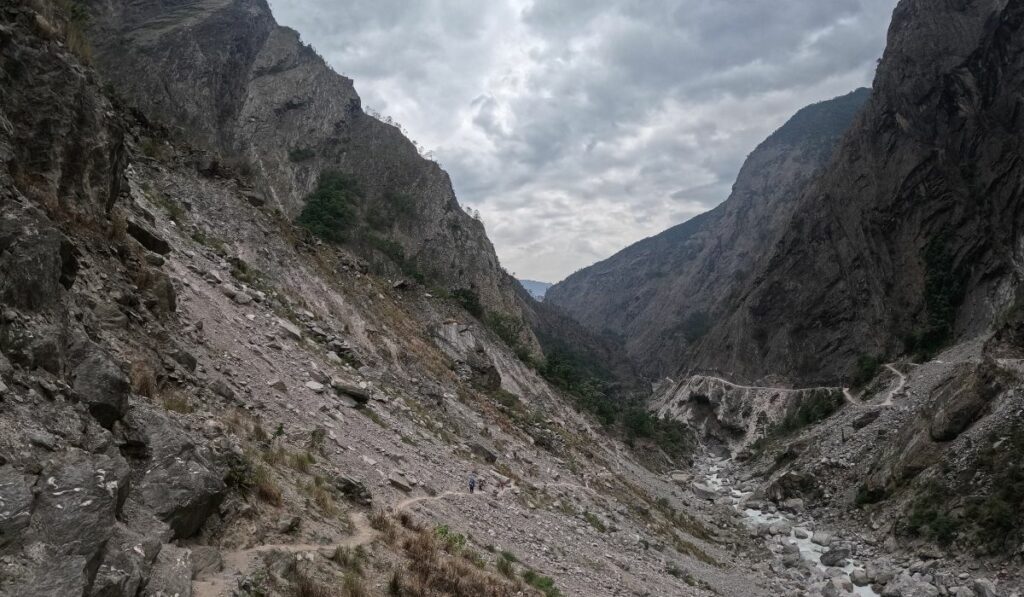
The Tsum Valley trek difficulty may vary from person to person depending on their previous experience and fitness. Below, we have explained everything related to the difficulty, altitude sickness, and preparation.
Difficulty of the Tsum Valley
Trekking Tsum Valley is challenging in Nepal. It is not as high as the popular Annapurna Circuit or Everest Base Camp treks, but the terrain is offbeat, involves many steep ascents and descents, and navigates landslide areas.
Though the terrain is not steep throughout the way, you will come across many sharp uphill and downhill tracks. Another major challenge of the trek is its remote location and scarce tourist infrastructure.
If you have trekked in the Langtang, Everest, or Annapurna region before and are expecting the same kind of services for trekkers, you will be disappointed.
Tsum Valley is an untouched part of the Himalayas. The trail has tea houses, but the services are very limited. You will experience an authentic mountain lifestyle on this trek.
In addition to that, you will walk 6 to 7 hours a day during the trek, which demands strong fitness. Previous trekking experience will help you a lot on the Tsum Valley trek.
Altitude sickness on the Tsum Valley trek
You will start the trek to Tsum Valley from 730 meters and ascend to 3,700 meters. Although you will gain this altitude gradually, you can feel its effects once you ascend over 2,500 meters.
Hiking slowly is best to acclimate and avoid altitude sickness. Note that everybody reacts differently to high altitude, and we never know how you will adapt to it.
So, give your body time, enjoy nature, and ascend slowly. High altitude makes trekking difficult because above 2,500 meters, oxygen begins to drop, and the higher you go, the lower the oxygen level will be. So, you will get tired quickly, and every step becomes tough.
Therefore, good fitness and previous high-altitude experience help a lot during high-altitude treks like Tsum Valley. Altitude sickness is also known as Acute Mountain Sickness (AMS).
Its early signs are nausea, dizziness, vomiting, headache, fatigue, insomnia, difficulty breathing, and loss of appetite. The symptoms can get severe if not handled on time, so please inform your guide and get help from him if you see these symptoms.
Ways to handle altitude sickness
- Acclimatization: Acclimatization means getting used to high elevation. The most effective way to acclimate is by ascending slowly. We usually include a dedicated acclimatization day in our itineraries. In the case of the Tsum Valley trek, we have an acclimatization day in the Nile settlement. As per the rule of acclimatization day, you will hike to a high altitude and return to the same village to spend the night.
- Hydration: Your body has to stay hydrated to maintain an optimal condition during trekking. A dehydrated body is more likely to suffer from altitude sickness. Therefore, drink at least 2 liters of water daily during the hike and combine soups and ginger-honey teas in your meals every day.
- Ascend slowly and maintain a consistent pace: As we keep saying, ascending slowly will allow you to get used to the rise in elevation. You will not get tired easily and exhaust yourself too much. We highly recommend taking quick breaks to take deep breaths. Himalayas demand patience, and you will not win going against it.
- Enough sleep and food: You have to eat and sleep well during the trek to be in the best condition. Carbohydrate-rich food is best while hiking in the mountains. It will provide ample energy to walk long hours on rugged terrain. Similarly, you have to rest well to recover and walk another day. Go to bed on time and get a good night’s sleep every day.
- Do not hesitate to seek help: If you feel discomfort, ask your guide’s help immediately. Do not hesitate to ask for help. It is important to address any issue as early as possible in the mountain to avoid its severe state.
How do you prepare for the Tsum Valley trek?
By reading the difficulty and demands of the Tsum Valley trek, you must have understood that this trek requires good fitness, health, and previous high-altitude experience.
You can do the following things to prepare for the Tsum Valley trek:
- Fitness: Strength training and cardio exercises are best for getting fit for the Tsum Valley trek. Train your legs, core, and shoulders. Likewise, add 30 to 45 minutes of cardio exercise like running, cycling, or swimming after strength training. It will improve your stamina and endurance.
- Regular walking: During the Tsum Valley trek, you have to walk 6 to 7 hours a day. Walking 6 to 7 hours a day while hiking will become very challenging without a habit. So, go on regular long walks to make a habit. Ideally, carry a backpack weighing 5 kg during the walk.
- High altitude experience: You can get high altitude experience by going on day hikes or easier multi-day treks. It will also help you experience uphill and downhill walking.
- Mental preparation: You will push your brain limits while exercising and walking for long hours, which is great for the Tsum Valley trek. In addition to that, we also recommend seeing videos and reading blogs on this trek to set the right expectations.
Accommodation & Food
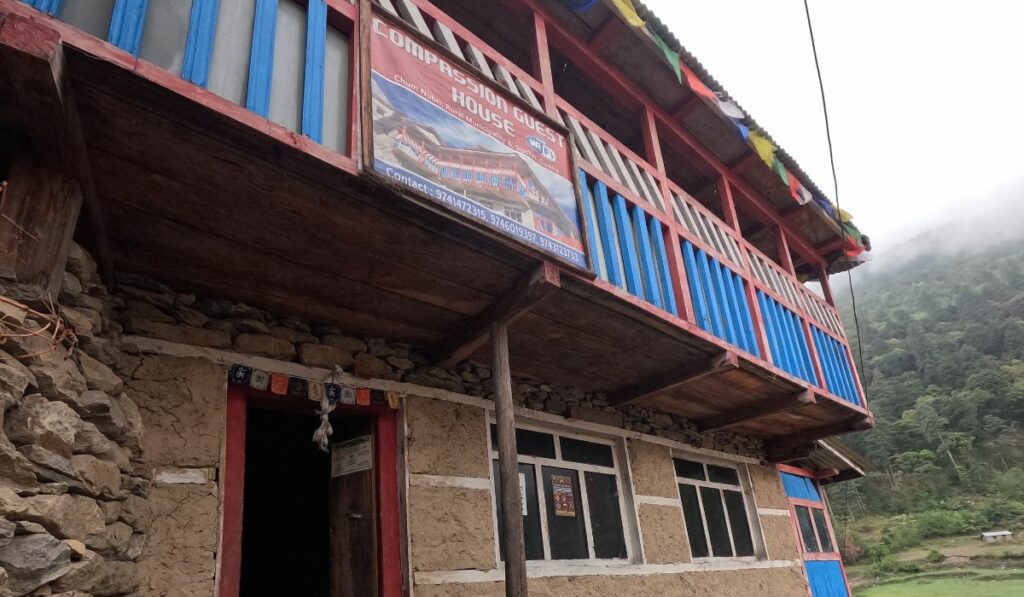
- Tea house accommodation: Basic but comfortable, mostly family-run.
- Must-try local cuisine: Dal Bhat, Tibetan bread, thukpa, thenduk, Tibetan butter tea, and momos.
- Limited services: Fewer amenities compared to Everest or Annapurna routes.
The accommodation on the Tsum Valley trek is very simple. All the tea houses are runned by the local families. The rooms will be small but clean and comfortable.
We will hand-pick the best available rooms, but you have to adjust a lot. Private washrooms are usually not found in the teahouses.
In villages like Soti Kola, Machha Khola, and Jagat, Western-style toilets are available, but as you go higher, squat toilets are normal. Rooms are shared between two or three trekkers.
Everyone gets separate beds and clean bedding. The sleeping bag is a must on the Tsum Valley trek. It will provide extra warmth at night because the temperature drops significantly.
Hot showers and charging are available in all tea houses at an additional charge. Depending on the altitude, it can cost you anywhere from USD 1 to USD 7.
Accommodation tips:
- You will get blankets in the teahouses, but it is not enough to keep you warm on cold nights. So, carry a high-quality sleeping bag.
- Dining rooms are a heated area in the teahouse. Spend some time after dinner and warm up before heading to sleep.
- Pack toilet paper, soap, hand sanitizer, wet wipes, and other required toiletries for the trip. Do not rely on tea houses for anything.
- Hot water costs USD 2 to USD 5 every time.
- Charging costs USD 1 to USD 3 per device.
Food on the Tsum Valley trek
With accommodation, tea houses provide meal services to the trekkers. Our overall Manaslu region trek package includes breakfast, lunch, and dinner each day during the trek. You can pick the food of your choice from the menu.
The food options are not as extensive as in the Everest and Annapurna regions. Still, you will have decent choices such as fried rice, dal bhat, pasta, momo, Tibetan bread, porridge, soups, fried noodles, eggs, rice pudding, pancakes, teas, coffee, and soft drinks.
Tips on food:
- Avoid drinking local wine and alcoholic beverages while ascending. It will dehydrate your body, and you do not want to deal with a hangover at high altitude. You can try them while returning from Mu Gompa.
- Limit meat consumption while trekking. Ask your guide to check the meat’s freshness before ordering it. In the remote areas, refrigeration systems are limited, so eating meat is risky. You may get stomach problems or indigestion.
- Carry nuts, protein bars, chocolate, and other snacks for the journey. Buy lots of them in Kathmandu.
- Note that you will have dinner and breakfast in the same tea house you spend the night at, and lunch on the way.
- You can order additional snacks apart from the three meals a day included in our package. Kindly carry ample cash with you for personal expenses like this.
- Vegetarians will have an excellent time during the trek. The menu has a better variety of vegetarian food than non-vegetarian food.
- If you have any food allergies, inform us during booking and remind your guide once the trek starts.
Drinking water on the trek
Tap water and water from streams in the Himalayas are hard, and you may get indigestion. It is best to avoid drinking water directly from these sources.
However, you can use water purification tablets before drinking water from these sources. Our best drinking water option during the trek is buying boiled water from the tea house at a low price.
Carry a Nalgene water bottle. A water bladder is highly recommended.
Packing List for Tsum Valley Trek
During the Tsum Valley trek or any trek in the Himalayas, you have to wear appropriate clothes and shoes for flexibility and support.
Wearing clothes in the right layer is also important, as it will help you maintain your body temperature. You can also remove the outer layer easily if it gets too hot while walking.
We have written a dedicated blog on how to wear clothes during trekking in the Himalayas, along with much other information. Kindly read this blog for more details.
Follow the list below while packing for the Tsum Valley trek in Nepal:
Clothing:
- Breathable/comfortable underwear
- Base layer (trekking t-shirts and pants)
- Thermal layer
- Long-sleeved hiking shirt and hiking shorts/leggings
- Fleece jumpers
- Waterproof/rainproof jacket and pant
- Down jacket
- Liner socks, fuzzy socks, liner gloves (touch screen compatible), thermal gloves, beanies (2), scarves
- Neck gaiter and sun hat
Trekking gear:
- Trekking boots
- Normal shoes or slippers to wear in the lodge
- Trekking poles
- Daypack
- UV Sunglasses
- Duffel bag
- Water bottle
- Water purifying tablets
Miscellaneous:
- Trek map
- First aid kit
- Hand sanitizer
- SPF, lip balm, moisturizer, comb, pocket mirror
- Toiletries, including wet wipes, toilet paper, hand wash, shampoo, etc
- Snacks
- Camera, spare batteries, power bank, Universal adapter
- Pocket torch and knife
- Journal and pen
- Ziplock bag to store used clothes and food
Documents:
- Passport size photos
- Passport (at least six months of validity)
- Nepali tourist visa
- Credit/debit card
- Cash
- Travel insurance document
- Emergency contact and address
Why Choose Mountain Routes for the Tsum Valley Trek?
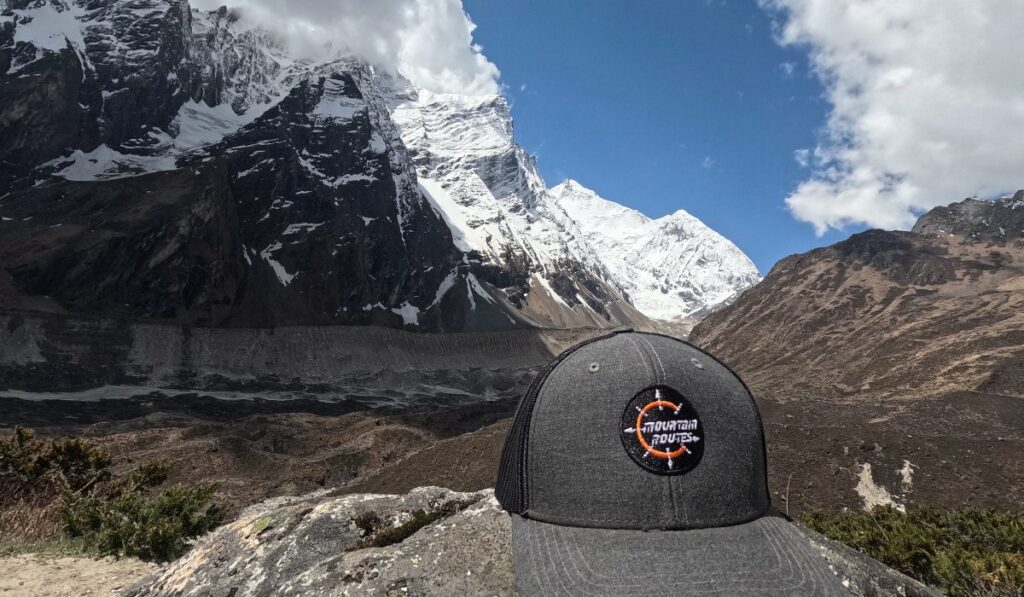
Trekking in the Himalayas, especially touching the remotest corners like Tsum Valley, demands support from a local Nepali trekking company like ours.
Mountain Routes is your best trekking partner in Nepal because of our deep-rooted ties with the mountains and long-standing expertise. We can help you create unforgettable journeys while ensuring your safety and convenience.
We have dedicated teams to assist you in airport departures, obtain necessary permits, arrange transportation and make reservations, and trek with you in the mountains.
In short, we take care of all the logistics involved during the Tsum Valley trek, provide a professional mountain guide and porter, and ensure your safety and satisfaction.
While trekking with us, you not only enjoy the best price and service but also get access to our deep knowledge about the region!
Reasons to Plan your Nepal Trek with Mountain Routes
- Many years of trail experience: We have been organizing treks for travelers from around the world for many years, so our knowledge and expertise are quite extensive.
- Top-notch trek service: Our team has first-hand experience providing the best trek service. We understand the needs of our trekkers, so we provide an international standard service with the zest of Nepali heritage mixed with it.
- Flexible itinerary: You can customize any itinerary with us. We understand our proposed itinerary may not meet your time, fitness, and interests, so we are always ready to curate the itinerary as per our guests’ requests.
- Best guides and porters: Our guides and porters are the best because of the way we have trained them. Not only that, they are also helpful and entertaining individuals with lovely personalities. You will learn a lot from them. They will make sure you are safe in the mountains and enjoying the trip to the fullest.
- Sustainable and responsible trek practice: You will only leave your footprint behind with us. We organize our treks responsibly and highly contribute to the locals’ livelihoods. Likewise, we make sure our journeys do not harm nature in any way.
- 24/7 support: Our team will be available 24/7 to assist you in the mountains. From the start to the end of the journey, we will do our best to make your time in Nepal hassle-free. You can freely contact us anytime to ask any questions.
- Best package costs and no hidden charges: One of our goals is to make the Himalayas accessible for all budgets. Regardless of your budget, we do our best to curate tailor-made trips so that you can enjoy the beauty of Nepal in whatever way possible. Likewise, there are no hidden charges with us. We will pre-inform you about all expenses you can expect during the Tsum Valley trek or any other trip with us in Nepal.